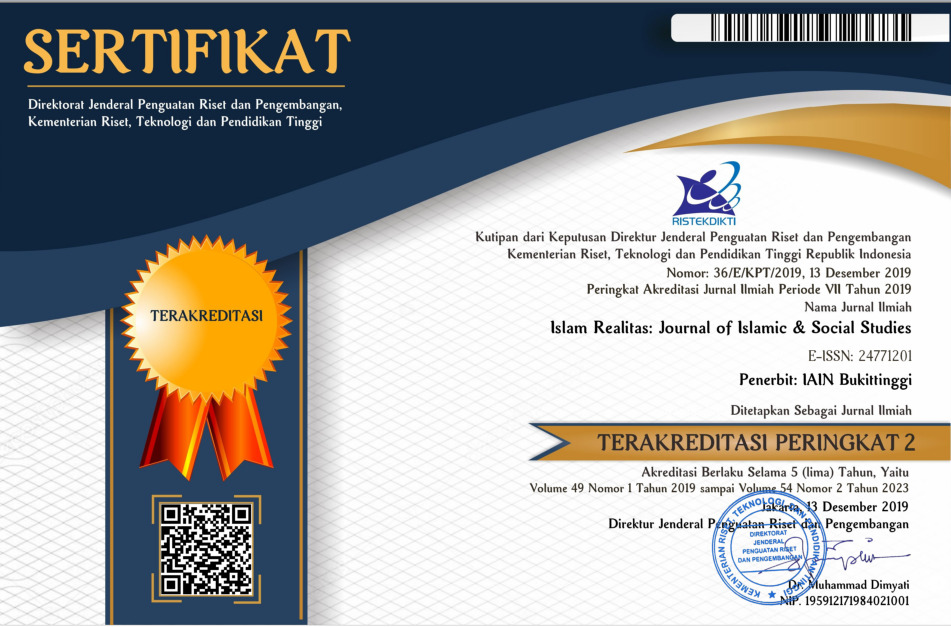Religious Expression of Hijrah Celebrity: Accommodating Protest and Political Economy of Public Piety
Downloads
The hijrah campaign or massive movement that invites Muslims to become a better person by practicing religious teachings is more vigorously voiced in the digital era, including on social media, as we can find on ‘detiknews’ that the hastag #hijrah in the instagram search box more than 1,7 million posts. The hijrah account on facebook has also been followed by more than 300 thousand accounts. This phenomenon cannot be denied also by the artists, because this phenomenon is massive in the middle to upper class, who have the opportunity to consume issues trending or viral on social media. The trend in hijrah activities also influenced a series of celebrities who decided to hijrah with different processes. I assume that celebrities who do hijrah actually want not only to show their new religious expression by showing their peity to the public but also to be  a form of ‘accomodating protest’ that before they decide to hijrah, there is a kind of bullying that is the emergence of stigmas of a fear of a decline in their image in public when an artist hijrah with his new hijab style, but instead there is a kind of resistance that celebrities want to come out to public that they can still exist in even though wearing the hijab. There is also an political economic strategy played by the artists by making some innovations such as halal industry. This is their target because the trends have been becoming a massive consumerism trend by the millenial Muslim middle class, which is believed to be economic booster of the 21st century.
Â
Kampanye hijrah atau gerakan massif yang mengajak kaum Muslim untuk menjadi pribadi yang lebih baik dengan menjalankan ajaran agama semakin gencar disuarakan di era digital. di era digital, termasuk di media sosial, sebagaimana dapat kita temukan di ‘detiknews’ bahwa tagar #hijrah di kotak pencarian instagram terdapat lebih dari 1,7 juta postingan, akun hijrah di facebook juga sudah diikuti lebih dari 300 ribu akun. Fenomena ini tidak bisa dinafikan juga dari kalangan artis, karena fenomena ini masif ditemui di kalangan kelas menengah ke atas yang berkesempatan mengonsumi isu-isu yang menjadi tren atau viral di media sosial. Tren aktivitas hijrah ini pun mempengaruhi sederet selebriti yang memutuskan untuk hijrah dengan proses yang berbeda-beda. Saya berasumsi bahwa selebriti yang melakukan hijrah sebenarnya tidak hanya ingin menunjukkan ekspresi keberagamaan barunya dengan menunjukkan kesalehannya terhadap publik, tetapi juga sebagai sebuah bentuk ‘accomodating protest‘ bahwa sebelum mereka memutuskan untuk hijrah ada sejenis bully-an yaitu munculnya stigma-stigma ketakutan menurunnya citra mereka di hadapan publik ketika seorang artis melakukan hijrah dengan style hijab barunya, tetapi justru ada semacam perlawanan yang ingin ditunjukkan oleh para selebriti kepada masyarakat bahwa mereka tetap bisa eksis walaupun memakai jilbab dan juga ada strategi politik ekonomi yang dimainkan oleh artis-artis hijrah tersebut dengan membuat inovasi-inovasi industri halal, tren hijab yang semakin down-to-earth, dan yang lainnya. Industri halal tersebut menjadi sasaran mereka karena tren tersebut menjadi tren konsumerisme yang masif oleh kelas menengah Muslim milenial yang diyakini sebagai penggerak ekonomi abad-21.
Books
Ahzami S.J, Hijrah dalam Pandangan Al-Qur’an (Jakarta: Gema Insani, 2012)
Arlene Elow Macleod, Accomodating Protest: Working Women, the New Veiling and Change in Cairo (New York: Columbia University Press, 1991)
Bayat, Asef, Making Islam Democratic: Social Movement and The Post-Islamist Turn (Stanford: Standford University Press, 2007)
Bourdieu P, Distinction: A Social Critique of the Judgement of Taste (Taylor & Francis, 2013)
---------, Reproduction in Education (London and Beverly Hills: Sage, 1977)
Cashmore, Celebrity/Culture (New York: Routledge, 2006)
Chaney, David, Lifestyles : Sebuah Pengantar Komprehensif (Bandung: Jalasutra, 1996)
El-Guindi, Fedwa, Jilbab Antara Kesalehan, Kesopanan, Dan Perlawanan (Jakarta: Serambi Ilmu Semesta, 2004)
Geertz, Clifford, Kebudayaan dan Agama (Yogyakarta: Kanisius, 1992)
Geertz, Clifford, The Interpretation of Culture (New York: Basic Book, 1973)
Gerungan, Psikologi Sosial (Bandung: Eresco, 1996)
Harvey, David, The Condition of Posmodernity (Cambridge: Basil Blackwell, 1997)
John, Willam, The Political Economy of Communication, 2nd edn (London: Sage Publication, 2009)
Laughey, D, Media Studies:Theories and Approaches (London: Oldcastle Book, 2010).
Pepinsky, Thomas B., R. William Liddle, and Saiful Mujani, Piety and Public Opinion: Understanding Indonesian Islam (New York: Oxford University Press, 2018)
Riesebordt, Pious Passion (Berkeley: University of California Press, 1993)
Roy, Oliver, The Failure of Political Islam (Cambridge: Harvard University Press, 2003)
Shimp, Torence A, Perikanan Promosi, Aspek Tambahan Komunikasi Pemasaran Terpadu (Jakarta: Erlangga, 2003)
--------, Promotion Management and Marketing Communications (Orlando: The Dryden Press, 1990)
Journals
Aparno, Rao, ‘The Many Sources of Identity: An Example of Changing Affiliations in Rural Jammu dan Kashmir’, 22.1 (1999), 56
Aswadi, ‘Refomulasi Epistemologi Hijrah dalam Dakwah’, Islamica, 5. 2 (2011), 339–53
Basante, Pamela Nunez, ‘Beyond the Veil: Media Prejudice Towards the Use of the Hijab’, International Journal for Intersectional Feminist Studies, 5.1–2 (2019), 13–21
Fitri, Rahmi Nur and Indah Rama Jayanti, ‘Fenomena Seleb Hijrah: Tendensi Eksklusivisme dan Kemunculan Kelompok Sosial Baru’, Muharrik: Jurnal Dakwah dan Sosial, 3. 1 (2020), 1
Hasbullah, Moeflich, ‘Teori Habitus Bordieu dan Kehadiran Kelas Menengah Muslim Indonesia’, Khazanah, 21. 1 (2007), 5
Hassim, Nurzihan, ‘Hijab and the Malay-Muslim Woman in Media’, Procedia Social and Behavioral Sciences, 155. 1 (2014), 428–33
Ismail, Muhammad Taufik and Zaenal Abidin, ‘Kontekstualisasi Hijrah Sebagai Titik Tolak Pembaharuan Pendidikan’, Suhuf, 29, 2.1 (2017), 56-57
Istiani, Ade Nur, ‘Kontruksi Makna Hijab Fashion Bagi Moeslem Fashion Blogger’, Jurnal Kajian Komunikasi, 3.1 (2015), 51
Jati, Wasisto Raharjo, ‘Kesalehan Sosial Sebagai Ritual Kelas Menengah’, Jurnal Kebudayaan Islam, 13. 2 (2015), 346
Latif, Zulkifli Abd. and Fatin Nur Sofia Alam, ‘The Roles of Media in Influencing Women Wearing Hijab:An Analysis’, Journal of Image and Graphics, 1.1 (2013), 50
Lyansari, Kirana Nur, ‘Hijrah Celebrity: Creating New Religiosities, Branding Economics of Lifestyle in the Age of Muslim Mass Consumption’, Analisis: Jurnal Studi Keislaman, 18. 2 (2018), 211–32
Manggaga, Indah Pratiwi, ‘Komodifikasi Konten Televisi dalam Perspektif Ekonomi Politik Media’, Jurnal Tabligh, 19. 2 (2018), 259
Nistor, Laura, ‘Hijab (Istas) as Fashion Phenomenon’, Acta Univ, Sapientiae, Social Analysis, 7. 1 (2017), 59
Posetti, J.N, ‘Media Representations of the Hijab’, Journalism in Murlicultural Australia, Case Study 1, (2006), 1
Rofhani, ‘Budaya Urban Muslim Kelas Menengah’, Teosofi, 3. 1 (2013), 200
Rozaki, Abdur, ‘Komodifikasi Islam: Kesalehan dan Pergulatan di Ruang Publik’, Jurnal Dakwah, 2. 4 (2013), 201–2
Shirazi, Faegheh and Smeeta Mishra, ‘Young Muslim Women on the Face Veil (Niqab) : A Tool of Resistance in Europe but Rejected in the United States’, International Journal of Cultural Studies, 13. 1 (2010), 43–62
Yusuf, Muhammad Fahrudin, ‘Komodifikasi: Cermin Retak Agama di Televisi:Perspektif Ekonomi Politik Media’, Inject: Interdisciplinery Journal of Communication, 1, 1 (2016), 25–42
Others
Hair, Abdul, ‘Fenomena Hijrah di Kalangan Anak Muda’, Detik New 7 (Jakarta, 2018)
Moerwanto, Kris, ‘Bangkitnya Kelas Menengah dan Perubahan Perilaku Pasar’, Jawa Pos (Surabaya, 2011)
Authors who publish with this journal agree to the following terms:
- Authors retain copyright and grant the journal right of first publication with the work simultaneously licensed under a Creative Commons Attribution License that allows others to share the work with an acknowledgment of the work's authorship and initial publication in this journal.
- Authors are able to enter into separate, additional contractual arrangements for the non-exclusive distribution of the journal's published version of the work (e.g., post it to an institutional repository or publish it in a book), with an acknowledgment of its initial publication in this journal.
- Authors are permitted and encouraged to post their work online (e.g., in institutional repositories or on their website) prior to and during the submission process, as it can lead to productive exchanges, as well as earlier and greater citation of published work (See The Effect of Open Access).









